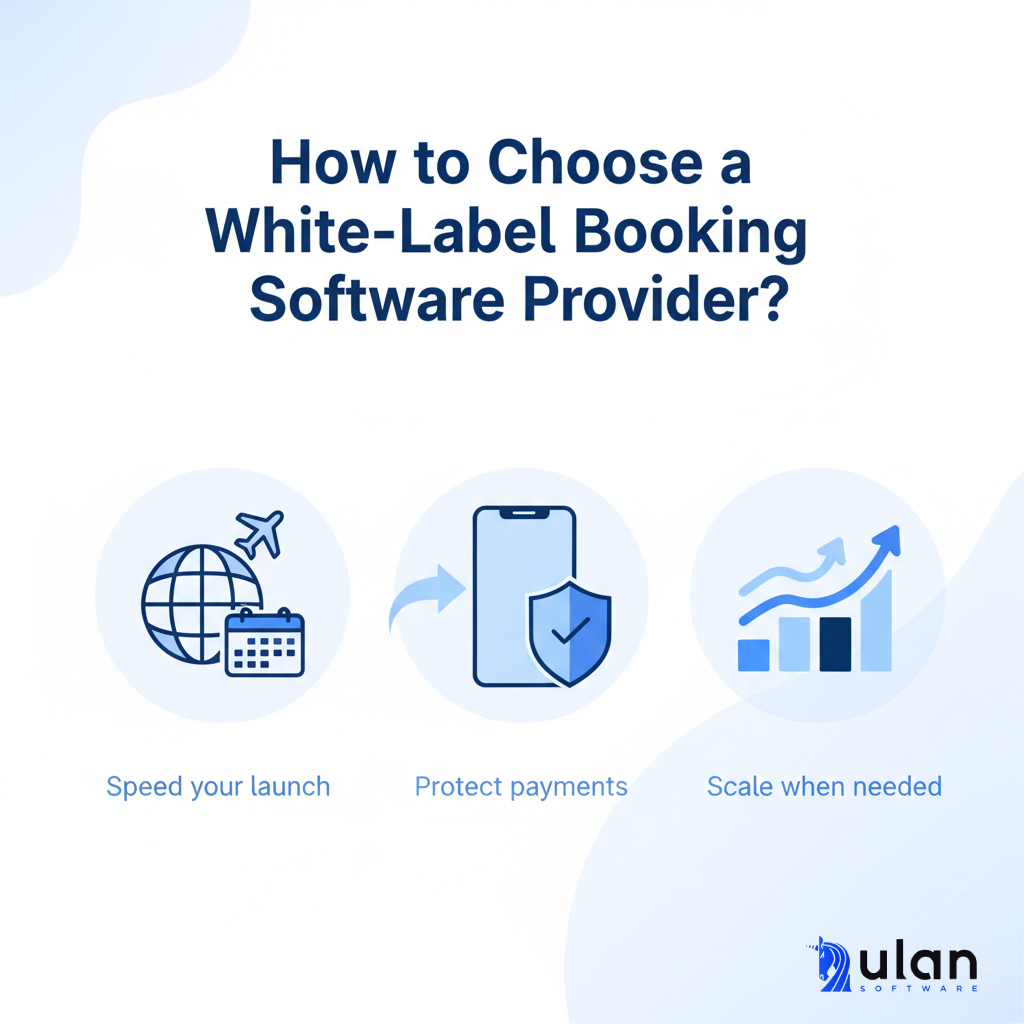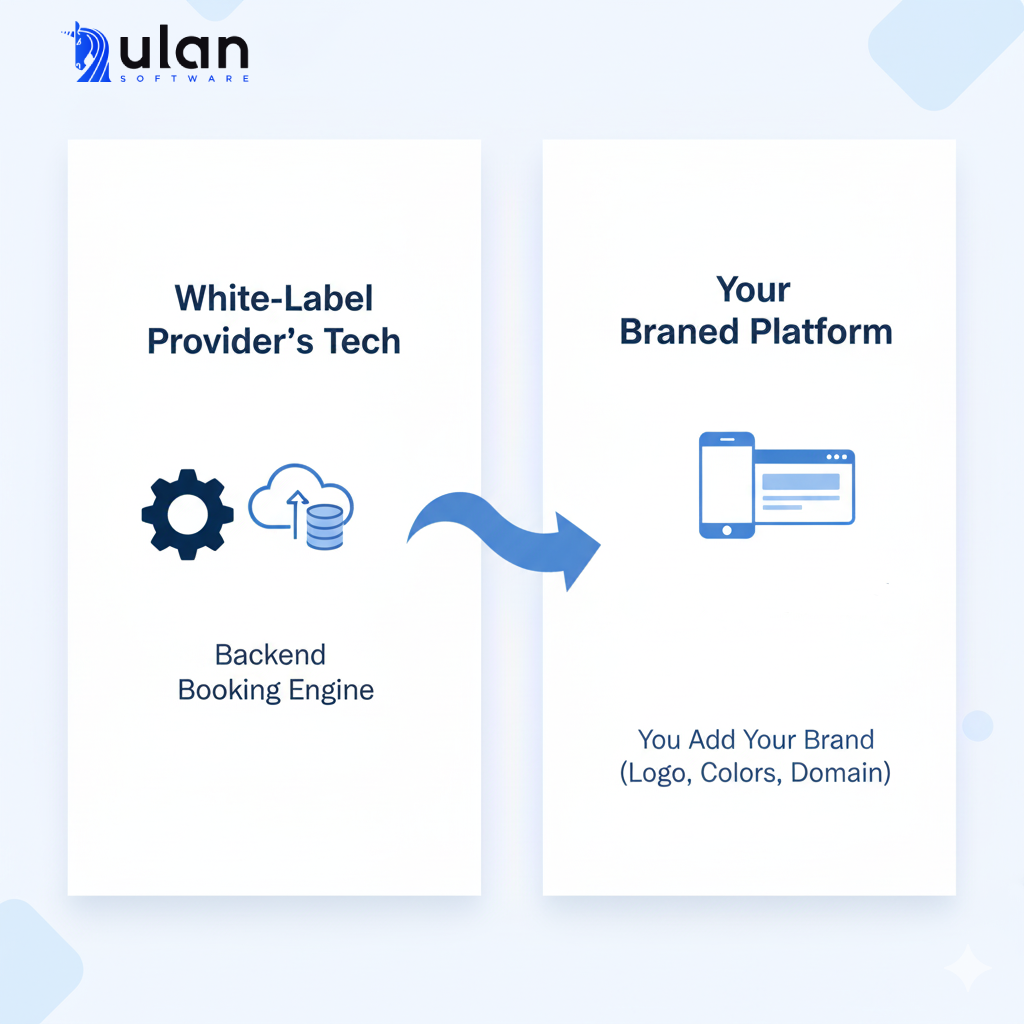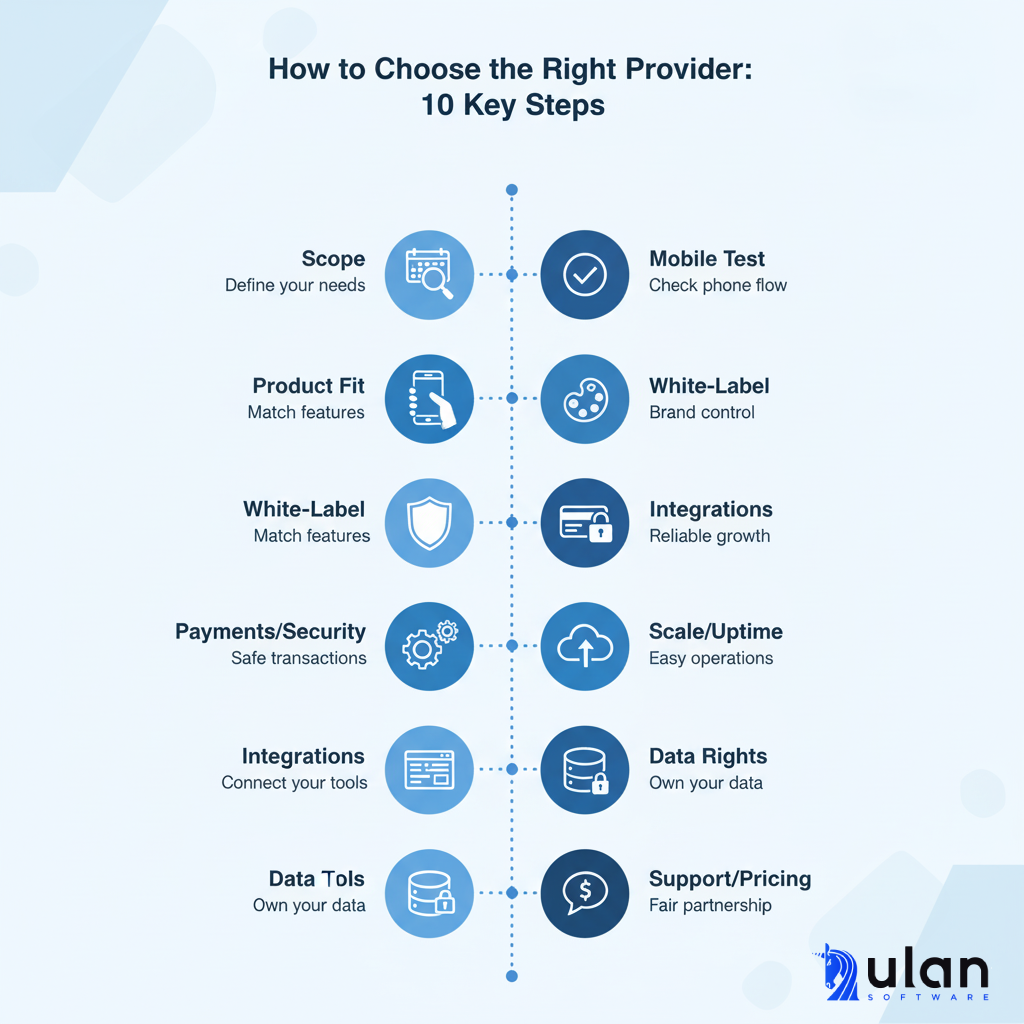Back to all Articles
Karol Andruszków
Karol is a serial entrepreneur who has successfully founded 4 startup companies. With over 11 years of experience in Banking, Financial, IT and eCommerce sector, Karol has provided expert advice to more than 500 companies across 15 countries, including Poland, the USA, the UK, and Portugal.
How to Choose a White-Label Booking Software Provider
Updated:
Thu, Oct 30
Reading time: 8 minutes

Choosing a booking platform is usually a strategy choice, not a feature hunt. The right booking solution will speed your launch, protect payments, and scale when you will need it. Market data also shows why careful selection matters.
Online carts still see around 70% abandonment, so a fast, clear checkout is vital. Travel bookings continue to grow, with mobile usage rising each year. These trends shape what to ask and what to test.
In this article, we give you a clear process you can follow today. Each section covers:
What Is a White-Label Booking Software Provider?
Online carts still see around 70% abandonment, so a fast, clear checkout is vital. Travel bookings continue to grow, with mobile usage rising each year. These trends shape what to ask and what to test.
In this article, we give you a clear process you can follow today. Each section covers:
- A simple process to shortlist and compare vendors.
- The core features you should not compromise on.
- Data, security, and support checks that protect your brand.
- Pricing traps to avoid and how to judge ROI.
What Is a White-Label Booking Software Provider?
A white label booking software provider offers a pre-built booking system that other businesses can use and brand as their own. In practical terms, the provider supplies the backend booking engine, and you get to put your brand’s name, logo, and design on it. Your customers make reservations on your website or app as if you built the system, but the heavy lifting is done by the white label provider’s technology.
This means you can sell bookings for flights, events, appointments, or other services under your own brand without developing the software in-house.
First of all, it lets you offer online bookings quickly and cost-effectively using battle-tested and proven technology. As a result, you avoid reinventing the wheel. The provider handles all the technical parts on the backend, while you concentrate on your core business and marketing.
In short, a white label booking software provider becomes a behind-the-scenes partner powering your bookings, allowing you to enter the market faster and with lower upfront costs.

Why Choose a White Label Solution Over Building Your Own?
Selecting a white-label booking software is often the smarter, faster, and safer path than building it from scratch. It lets you focus on your core business while relying on proven technology to power bookings.
Key advantages include:
In the next sections, we will guide you step-by-step on how you choose the right provider that will suit your needs.

Step 1: Define the booking scope
Scope drives fit. Write one page that lists:
Keep this page handy. You will use it in every vendor call.
Step 2: Check core product fit
Shortlist vendors that already cover your use case. Do not accept “custom later” for basics.
Must-haves you should be aware of:
Why so strict? Slow or complex flows drive high drop-off.
Step 3: Test the mobile experience
Most discovery now starts on a phone. Mobile travel bookings alone were valued at about $228B in 2024, with long-term growth ahead. A thumb-first flow is no longer optional.
Do four quick tests:
Step 4: Verify white-label depth
A true white-label looks and feels like your product.
Non-negotiables:
Ask to see live client sites. Look for any trace of the vendor brand.
Step 5: Confirm payments and compliance
Payments must be flexible and safe. Require support for major gateways and wallets. Confirm that card data never touches your servers. Demand clear evidence of PCI DSS compliance. PCI DSS defines baseline controls for handling cardholder data. PCI Security Standards Council
Payment checklist for you:
Friction at checkout fuels abandonment, which is already high in travel. Some hospitality studies report abandonment over 80% for complex flows.
Integration map:
Ask for a working example of each critical link. Review API limits and event coverage.
Market growth supports the case for scale. Major platforms reported double-digit growth in room nights and bookings in late 2024.
Common models:
Watch for:
Project year-one and year-two costs at your target volume. Compare against likely gains from faster launch and higher conversion.

Key Takeaways
Choosing a white-label booking software provider shapes how fast you enter the market, how secure your transactions are, and how much effort your team spends maintaining technology.
The right choice blends proven tech, flexibility, and dependable support, without forcing you to reinvent what already works.
In short, the best provider acts as a long-term partner, not just a vendor. A thoughtful selection today ensures your booking platform runs smoothly, supports your brand, and scales with your business growth.
This means you can sell bookings for flights, events, appointments, or other services under your own brand without developing the software in-house.
Why so many companies choose white label solutions?
First of all, it lets you offer online bookings quickly and cost-effectively using battle-tested and proven technology. As a result, you avoid reinventing the wheel. The provider handles all the technical parts on the backend, while you concentrate on your core business and marketing.
In short, a white label booking software provider becomes a behind-the-scenes partner powering your bookings, allowing you to enter the market faster and with lower upfront costs.

Why Choose a White Label Solution Over Building Your Own?
Selecting a white-label booking software is often the smarter, faster, and safer path than building it from scratch. It lets you focus on your core business while relying on proven technology to power bookings.
Key advantages include:
- Faster TTM. Building a booking engine from zero can take a year or longer. A white-label solution can go live in weeks. You can test the market and generate revenue without delay.
- Lower development cost. Custom software requires specialized developers and large budgets.
- Proven stability and reliability. Established providers deliver platforms already tested in real-world conditions. You gain access to ongoing improvements, integrations, and performance refinements.
- Full brand control. Unlike affiliate programs that redirect customers elsewhere, white-label booking engines keep users on your site or app. This consistency builds trust, improves retention, and increases lifetime value.
- Ongoing updates and tech support. The vendor maintains the platform, manages new releases, and ensures compliance with payment and data standards.
In the next sections, we will guide you step-by-step on how you choose the right provider that will suit your needs.

Step 1: Define the booking scope
Scope drives fit. Write one page that lists:
- What people can book (rooms, tours, classes, tickets, services).
- How time works (slots, buffers, cut-offs, lead times).
- Who books and sells (B2C, B2B, partners).
- Where you operate (languages, currencies, taxes, time zones).
Keep this page handy. You will use it in every vendor call.
Step 2: Check core product fit
Shortlist vendors that already cover your use case. Do not accept “custom later” for basics.Must-haves you should be aware of:
- Clean search and calendar views.
- Fast checkout with guest and account flows.
- Holds, deposits, refunds, and no-show rules.
- Vouchers, coupons, fees, and taxes.
- Automated emails/SMS and ICS calendar adds.
- Accessible UI that supports keyboard and screen readers.
Why so strict? Slow or complex flows drive high drop-off.
Step 3: Test the mobile experience
Most discovery now starts on a phone. Mobile travel bookings alone were valued at about $228B in 2024, with long-term growth ahead. A thumb-first flow is no longer optional.Do four quick tests:
- Open the demo on 4G. Run a search. Note the delay.
- Complete a booking with one hand. Count the taps.
- Change dates and party size without losing context.
- Trigger an error. Read the message. Try recovery.
Step 4: Verify white-label depth
A true white-label looks and feels like your product.
Non-negotiables:
- Custom domain or CNAME.
- Full theme control (logo, colors, fonts, CSS hooks).
- Branded emails, SMS, and PDFs/tickets.
- Multi-language and multi-currency support.
Ask to see live client sites. Look for any trace of the vendor brand.
Step 5: Confirm payments and compliance
Payments must be flexible and safe. Require support for major gateways and wallets. Confirm that card data never touches your servers. Demand clear evidence of PCI DSS compliance. PCI DSS defines baseline controls for handling cardholder data. PCI Security Standards Council
Payment checklist for you:
- Stripe/Adyen/PayPal or local options are required.
- Apple Pay and Google Pay.
- 3-D Secure support where required.
- Fraud tools (AVS, CVV, velocity checks).
- Clear refund and chargeback flows.
Friction at checkout fuels abandonment, which is already high in travel. Some hospitality studies report abandonment over 80% for complex flows.
Step 6: Map integrations and extensibility
The booking engine should plug into your stack without hacks.Integration map:
- CRM and marketing tools.
- Accounting, invoicing, and tax engines.
- Supplier feeds, channel managers, or GDS/APIs.
- Webhooks and a documented REST API.
- SSO (OAuth/SAML) for partner or B2B portals.
Ask for a working example of each critical link. Review API limits and event coverage.
Step 7: Demand scale and uptime proof
You need speed on peak days and stability year-round. Ask for:- Uptime over the last 12–24 months and SLA terms.
- Load-test results and real event spikes.
- Auto-scaling on cloud and global CDN.
- A public status page and incident history.
Market growth supports the case for scale. Major platforms reported double-digit growth in room nights and bookings in late 2024.
Step 8: Review the admin and ops tools
Back-office pain becomes team cost. Admin essentials:- Fast search, edit, cancel, and rebook.
- Roles and permissions by task.
- Price rules, markups, fees, and taxes.
- Bulk updates and CSV imports.
- Audit logs and exportable reports.
Step 9: Confirm analytics and data rights
You own your data. Getting it out should be easy. Data questions:- Which standard reports ship by default?
- Are webhooks available for key events?
- Can we export to our warehouse daily or in real time?
- What are the retention and deletion controls under GDPR?
Step 10: Validate support quality
Support gaps turn into lost bookings. Support standards:- 24×7 for incident-level cases.
- Response times by severity, in writing.
- Named contact for onboarding and go-live.
- Public docs, release notes, and a roadmap.
Step 11: Compare pricing and model fit
Price should be transparent. Value should be clear.Common models:
- SaaS subscription by feature or volume.
- Per-booking fee or revenue share.
- One-time setup or implementation.
Watch for:
- Overage fees and paid “must-have” add-ons.
- Long lock-ins without exit terms or data export.
- Support is priced only as professional services.
Project year-one and year-two costs at your target volume. Compare against likely gains from faster launch and higher conversion.
Seven questions to close a vendor call
- Which parts are configurable vs. need customization engineering?
- What does a standard launch include and exclude?
- Which gateways and local payments are live today?
- How do you handle PCI DSS and fraud checks?
- What was your last 12-month uptime and worst incident?
- How can we export all data if we leave?
- What are the real limits (API, webhooks, users, bookings)?

Key Takeaways
Choosing a white-label booking software provider shapes how fast you enter the market, how secure your transactions are, and how much effort your team spends maintaining technology.
The right choice blends proven tech, flexibility, and dependable support, without forcing you to reinvent what already works.
In short, the best provider acts as a long-term partner, not just a vendor. A thoughtful selection today ensures your booking platform runs smoothly, supports your brand, and scales with your business growth.
Karol Andruszków
Karol is a serial entrepreneur who has successfully founded 4 startup companies. With over 11 years of experience in Banking, Financial, IT and eCommerce sector, Karol has provided expert advice to more than 500 companies across 15 countries, including Poland, the USA, the UK, and Portugal.
Table of Contents:
Recommended Articles
Thu, Nov 20
Top 15 UX Tips to Improve Conversion Rates in Travel Booking
Improve travel booking flow conversion with 15 proven UX tips. Learn how mobile design, pricing clarity, speed, and smart flows reduce friction and lift bookings.
Mon, Nov 17
What to Look for in Enterprise Booking Software?
Learn what to look for in enterprise booking software: key features, integrations, security, and data to guide your 2025 selection.
Thu, Nov 6
Best White-Label Booking Software in 2025
Discover the best white-label booking software in 2025 for travel, appointments, car rental and events, with pros, cons, pricing and real user reviews.


